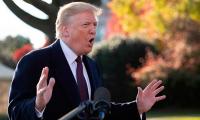HONG KONG: As Washington and Beijing trade barbs over the coronavirus pandemic, a longer-term struggle between the two Pacific powers is at a turning point, as the United States rolls out new weapons and strategy in a bid to close a wide missile gap with China, a UK based news agency reported.
The United States has largely stood by in recent decades as China dramatically expanded its military firepower. Now, having shed the constraints of a Cold War-era arms control treaty, the Trump administration is planning to deploy long-range, ground-launched cruise missiles in the Asia-Pacific region.
The Pentagon intends to arm its Marines with versions of the Tomahawk cruise missile now carried on US warships, according to the White House budget requests for 2021 and Congressional testimony in March of senior US military commanders. It is also accelerating deliveries of its first new long-range anti-ship missiles in decades.
In a statement about the latest US moves, Beijing urged Washington to “be cautious in word and deed,” to “stop moving chess pieces around” the region, and to “stop flexing its military muscles around China.”
The US moves are aimed at countering China’s overwhelming advantage in land-based cruise and ballistic missiles. The Pentagon also intends to dial back China’s lead in what strategists refer to as the “range war.” The People’s Liberation Army (PLA), China’s military, has built up a huge force of missiles that mostly outrange those of the US and its regional allies, according to senior US commanders and strategic advisers to the Pentagon, who have been warning that China holds a clear advantage in these weapons.
And, in a radical shift in tactics, the Marines will join forces with the US Navy in attacking an enemy’s warships. Small and mobile units of US Marines armed with anti-ship missiles will become ship killers.
In a conflict, these units will be dispersed at key points in the Western Pacific and along the so-called first island chain, commanders said. The first island chain is the string of islands that run from the Japanese archipelago, through Taiwan, the Philippines and on to Borneo, enclosing China’s coastal seas.
Top US military commanders explained the new tactics to Congress in March in a series of budget hearings. The commandant of the US Marine Corps, General David Berger, told the Senate Armed Services Committee on March 5 that small units of Marines armed with precision missiles could assist the US Navy to gain control of the seas, particularly in the Western Pacific. “The Tomahawk missile is one of the tools that is going to allow us to do that,” he said.
The Tomahawk - which first gained fame when launched in massed strikes during the 1991 Gulf War - has been carried on US warships and used to attack land targets in recent decades. The Marines would test fire the cruise missile through 2022 with the aim of making it operational the following year, top Pentagon commanders testified.
At first, a relatively small number of land-based cruise missiles will not change the balance of power. But such a shift would send a strong political signal that Washington is preparing to compete with China’s massive arsenal, according to senior US and other Western strategists. Longer term, bigger numbers of these weapons combined with similar Japanese and Taiwanese missiles would pose a serious threat to Chinese forces, they say. The biggest immediate threat to the PLA comes from new, long-range anti-ship missiles now entering service with US Navy and Air Force strike aircraft.
“The Americans are coming back strongly,” said Ross Babbage, a former senior Australian government defense official and now a non-resident fellow at the Washington-based Center for Strategic and Budgetary Assessments, a security research group. “By 2024 or 2025 there is a serious risk for the PLA that their military developments will be obsolete.”
A Chinese military spokesman, Senior Colonel Wu Qian, warned last October that Beijing would “not stand by” if Washington deployed land-based, long-range missiles in the Asia-Pacific region.
The rule would be aimed at mail carriers, delivery people, construction workers, landscapers, restaurant staff and...
The Conservatives, who have been in power for the last 14 years, were predicted to win just 64 seats, which would be...
The sanction of the 80-year-old Giuliani, who spearheaded Trump´s legal efforts to overturn his election defeat, was...
Orban said he would report on his talks with Zelensky to EU prime ministers “so that the necessary European...
With the clock ticking to a deadline later Tuesday to register, over 200 pro-Macron or left-wing candidates had pulled...
Several nearby towns that rely on Calgary for water were also affected by the disruption.







